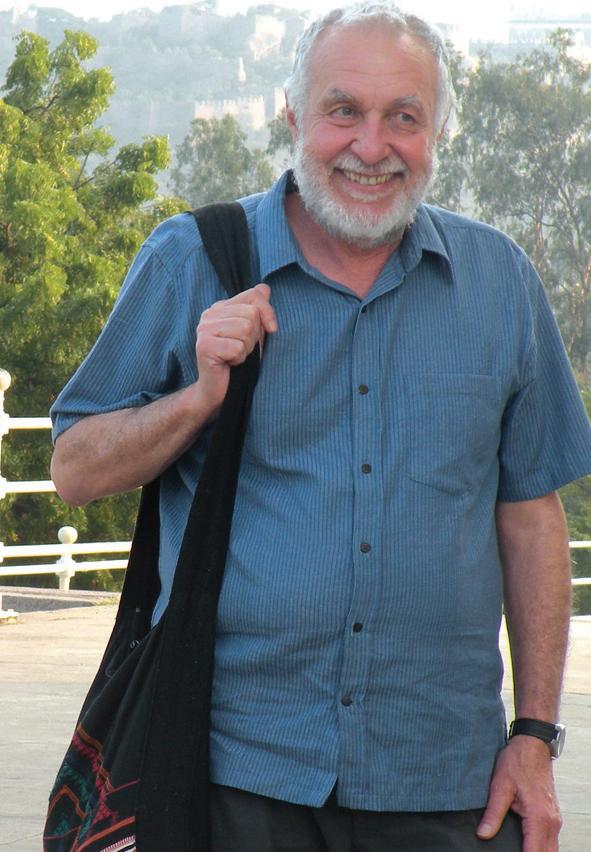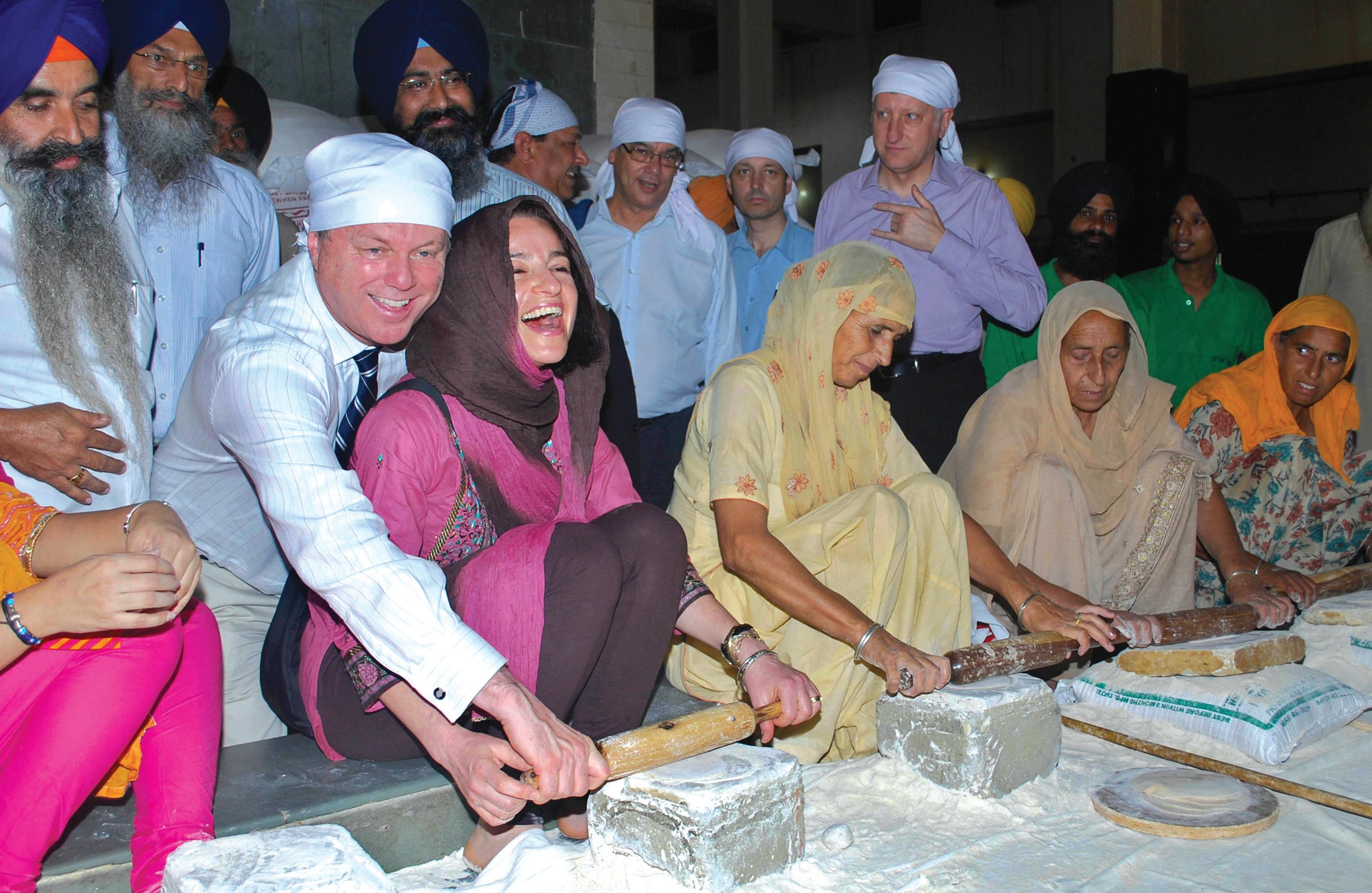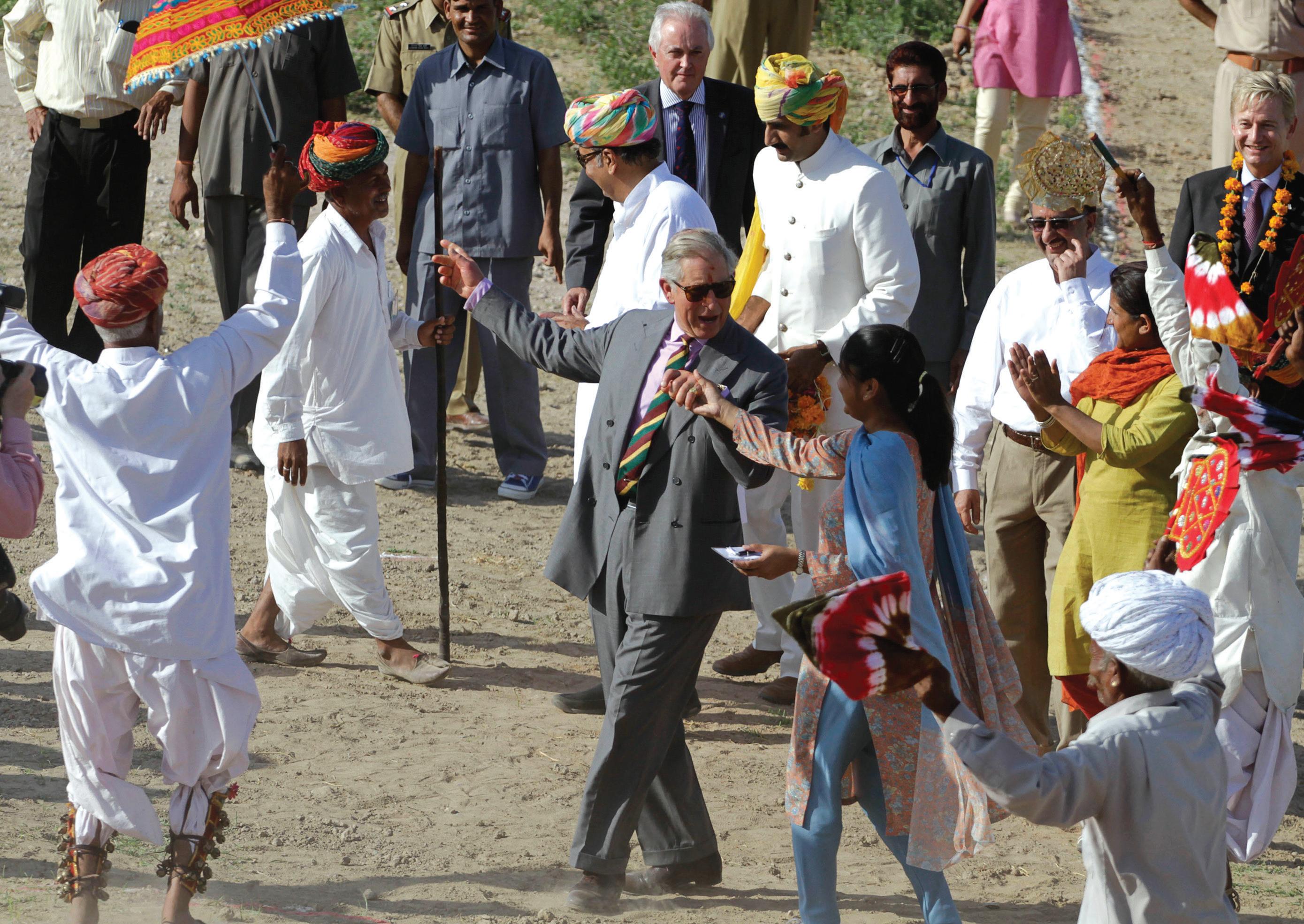
10 minute read
Rummaging through India’s history
from 2010-10 Melbourne
by Indian Link
that Dr Masselos developed an interest in using Indian origin objects to build up a sense of history.
BY SHIVANGI AMBANI-GANDHI
Scouring through junk shops in Australia and London, Dr Jim Masselos began his collection of the now large and wonderfully varied Portvale Collection. “I would go through shoe boxes full of photos and other material in shops full of all sorts of old objects. I accumulated the collection by hunting and rummaging. Now you can buy some such materials over eBay – it is far less exciting!” claims the historian.
The Indian Empire: Multiple Realities exhibition currently on show at the Art Gallery of New South Wales, presents a selection of objects from this collection built up over 40 years of travel across India, London and Australia. Dr Masselos is donating a large portion of the items in the exhibition to the Gallery.
Dr. Masselos, an honorary reader in history at the University of Sydney, has visited India over 50 times. His first visit in 1961 was to Mumbai to do his doctorate at St Xavier’s College under the Commonwealth Scholarship Scheme funded by the Government of India. His doctorate, about the rise of nationalism in Mumbai and Pune, was completed over a 4-year period in Mumbai leading to his book, Towards Nationalism

“When I came back to Sydney to teach, there were no visuals available, such as those now easily available on the internet,” he recollects. So he, along with a colleague, put together an exhibition of India-related objects at Sydney University in 1967. Included in this exhibition were objects from Sir James Plimsoll (Australian High Commissioner to India) and some from Mohenjodaro that had been gifted to the Nicholson Museum by the Indian Government. It was with this humble exhibition

One room of the exhibition is dedicated to beautifully embroidered textiles from Kutch and Saurashtra in Gujarat. “Lotika Varadarajan, who was also doing her doctorate at St Xavier’s at the time, got me interested in textiles,” says Dr. Masselos. “I decided to go to Kutch and look at the folk embroidery to create a sense of what preoccupied the women who wore this embroidery, and how they saw the world and depicted it in their designs.”
“I could have used French post-colonial theory to analyse their embroidery designs, but instead I decided to ask the women what their designs meant,” says Dr. Masselos. He found that although designs could have several different meanings in different areas of the region, one common image was of the famous story of women churning curd – but it had become so stylized that one couldn’t see the literal story in the image.
Another common symbol used by these women was that of a scorpion usually embroidered onto the left shoulder of the choli. This scorpion directed towards the heart, Dr Masselos found, symbolized the sudden pain of love, the love of Bhakti. Also included in the exhibition are the some cholis of the Maharani of Kutch who Masselos befriended over long conversations about her life. “Sometimes I think I know her better than I know anyone else!” says the collector.
Looking through the Empire exhibition though, it becomes apparent through the extensive display of photographs and albums, that Dr. Masselos has a particular interest in this medium. “At the time I was doing my research on Mumbai and I had to start collecting maps and drawings to build up a picture of what
India was like a century or so earlier,” says Dr. Masselos. “Now you just wouldn’t bother – you would just go on the internet and surf for pictures. The photographs were also visually very interesting, and my interest grew from seeing the photographs as just historical information to aesthetics as well; seeing them as images that are beautiful in their own right.”
One of the albums on display is a Panorama of Delhi, containing stunning images of the city in 1858. In a jointly authored book Dr Masselos has written an essay on Beato, the photographer of this album, while Delhi historian Narayani Gupta has written about the same places as they were then and as they are now in a book titled Beato’s Delhi. “We found that between the Old and New Delhi was another Delhi – the Delhi of the 1800s before the uprising of 1857, a Delhi that wasn’t Shahjahanabad nor the Delhi of Lutyens and the British raj, but was based around the Ridge and the then civil lines,” says Dr Masselos talking about this project. His other books include Bombay then and Mumbai now, (with Naresh Fernandes) and The city in action: Bombay struggles for power.
“India has been very well portrayed in early photographs. The way India is represented through these photographs and their sheer range; there is nothing in comparison to that in 19th century Australia. There was great attention paid to the Indian landscape as well as to the many different facets of Indian life and living under the British,” says Dr. Masselos.

“There is thus the Imperial view of British power that they convey, but also the picturesque.” And it is these multiple visions of India under the British Raj that is brought forth by the new exhibition of his collection.
The Indian empire, multiple realitiesSelections from the Portvale Collection, runs at the Art Gallery of New South Wales until November 7, 2010. Entry to the exhibition is free.

Ayodhya verdict: Waqf board resolves to move apex court
Virtually derailing efforts at a possible reconciliation, the Uttar Pradesh Sunni Central Waqf Board has said it is all set to take the Ayodhya legal battle to its logical next stage - the Supreme Court. An announcement to this effect was made by board chief Zufar Ahmad Farooqui in Lucknow.
“At a meeting of the board, we have resolved to file an appeal before the Supreme Court,” Farooqui told mediapersons.
“I am the sole spokesman of this board and nobody other than me is authorised to speak on behalf of this organisation,” he said.
The meeting was attended by nine of the 13 members of the board.
Soon after the Allahabad High Court’s verdict on the Ayodhya land dispute Sep 30, board counsel Zafaryab Jilani expressed his intention to appeal against the court’s verdict.
The high court decision seeks to divide the disputed 90 feet by 120 feet plot of disputed land into three equal parts among three litigants -- the Sunni Wakf Board, Hindu sect Nirmohi Akhara, and Ram Lalla (the ruling deity at the site).
There were six Muslim contestants including the board, whose stand was opposed by 90-year-old litigant Mohammad Hashim Ansari.
Ansari met Mahant Gyan Das, who wields considerable influence not only in Ayodhya but also among top Hindu priests, and urged him to jointly work out an amicable settlement of the Ayodhya issue.
Close on the heels of the initiative taken by 90-year-old Ansari for a negotiated settlement on the Ayodhya issue, the Nirmohi Akhara too has expressed its inclination to talk and resolve the dispute once and for all.
“I welcome the initiative taken by Mahant Gyan Das and Hashim Ansari and will be only too glad to be a party to the move for bringing the dispute to an amicable settlement and avoid another unending court battle,” Nirmohi Akhara chief Mahant Bhaskar Das said.
Significantly, while Ansari was the first Muslim to stake a legal claim to the Babri Masjid after it was usurped by Hindu mobs on the night of Dec 22-23, 1949, it was the Nirmohi Akhara which sought legal right to offer prayers at the disputed site way back in 1885.
It was Ansari who took the first step towards initiating a process of reconciliation instead of proceeding straight to the country’s apex court in appeal against the Sep 30 order of the Allahabad High Court.
Obama to visit India in Nov
US President Barack Obama will attend the US-India Business and Entrepreneurship Summit in Mumbai Nov 6 during his four-day visit to India, according to the
The trade advocacy group representing over 300 leading US companies doing business with India said its four-day Presidential Executive Mission to India will commence with a Business and Entrepreneurship Summit Nov 6.
Jointly organized with the US Department of Commerce, the summit featuring Obama “will help deepen America’s commercial relations with India, support American jobs, and strengthen the vital US-India partnership,” USIBC said.
“When Obama travels to India he will be the sixth-ever US President to set foot on Indian soil. His visit will be an actiontriggering event, where major business policy objectives can be advanced,” it said.
“The visit offers the opportunity to underscore that India will be one of the United States’ key partners in the decades ahead.”
In follow up to the Business and Entrepreneurship Summit, the USIBC Presidential Executive Mission will participate in business conferences in New Delhi Nov 8 and 9 to explore opportunities in bilateral investment, trade and innovation, USIBC said.
Besides Mumbai and New Delhi, Obama is also expected to visit Amritsar.

Salem’s trial for murder: Apex court clears way for verdict
The Supreme Court has cleared the decks for a designated Terrorist and Disruptive Activities (Prevention) Act (TADA) court to give its verdict in a Mumbai builder’s murder case in which don Abu Salem is the prime accused.
Juhu-based builder Pradeep Jain was murdered in 1995.
An apex court bench of Justice P. Sathasivam and Justice R.M. Lodha upheld the Maharashtra government’s plea that Salem could not cross-examine the accused-turned-approver Riyaz Ahmed Siddiqui, who was subsequently discarded by the prosecution.
Approver Siddiqui was discarded as witness as evidence tendered by him was not aiding the prosecution case and the plea for his pardon too was withdrawn. The other approver was Maim Khan.
Besides Salem, other accused in the case are Riyaz Siddiqui, Maim Khan, Mohammed Mahendi Hassan and V.K. Jhamb. They were accused of criminal conspiracy to eliminate Jain.
Speaking for the bench, Justice Lodha said that the question involved in the matter is whether an accused has a right to cross examine an accomplice-turned- approver who had tendered evidence as prosecution witness but pardon granted to him was withdrawn.
The judgment said that after the withdrawal of the pardon, the approverturned-prosecution witness relegates to the status of an accused and the evidence rendered by him (as an approver) becomes useless.
In such a situation, there is no scope for the other accused (Abu Salem and others in the instant case) to cross examine such a discarded approver-turned-prosecution witness, the court said.
The apex court faulted the TADA court in treating Riyaz Siddiqui as a hostile witness.
“It (TADA court) failed to consider that the pardon granted and accepted by him was conditional... inasmuch as it was on the condition of his making a true and full disclosure of all the facts concerning the commission of crime and once the pardon granted to him stood forfeited, he was relegated to the position of an accused and did not remain a witness,” the court said.
“In the circumstances, there was no justification to permit the defence to cross examine (such a discarded approver turned witness),” the judgment said.
It may be recalled that Salem had pleaded before the TADA court that he should be allowed to cross-examine both Siddiqui and Khan.
The plea was opposed by the prosecution on the grounds that it was not relying on their testimony as approver.
The state government took this position because it found that there was nothing in the testimonies of two approvers that could be counted upon by the prosecution in advancing their case against Salem and two others.
The prosecution had even withdrawn the grant of pardon to these two accusedturned-approver, the government said.
However, the TADA court allowed Salem’s plea to cross-examine the approvers.
It was against this order of the TADA court that the Maharashtra government moved the apex court.
While the apex court was seized of the matter it directed the TADA court to proceed with the trial but restrained it from pronouncing the verdict till it decided on the plea by the State government.
After the verdict of the apex court, the TADA court, which has already concluded the trial, is free to pronounce the verdict in the case.
At 21, you can serve liquor in Delhi, but won’t be served You can serve liquor at the age of 21 -- but can’t be served, stipulates the new Excise Act of the Delhi government, adding that women can be bar tenders too.
The Delhi Excise Act, 2009, that came into force on October 4, replaces the outdated Punjab Excise Act, 1914, which was extended to the national capital.
According to it, the age of employment of men in places where liquor is served has been reduced from 25 years to 21 years and restriction of employment of women has been done away with.
However, Excise Minister A.K. Walia told reporters that the age at which people can take liquor remains at 25.
The previous rule did not allow women to be bar tenders.
The new law has been enacted to overcome the problem of spurious and adulterated liquor, its smuggling and also its consumption in public places, Walia said.

Sportspersons donate memorabilia for Rahul Bose’s NGO
Do you fancy owning Sachin Tendulkar’s bat or Abhinav Bindra’s rifle? All you have to do is participate in an auction for which 26 prominent sportspersons have donated memorabilia that define iconic moments in their careers to raise funds for Bollywood actor Rahul Bose’s NGO.
At “Equation - An auction for Equality”, one can bid for, amongst others, Vishwanathan Anand’s world championship gold medal, the bat with which Sachin Tendulkar hit his fourth highest one-day score, the rifle with which Abhinav Bindra claimed the world championship, tennis shoes signed by Roger Federer and the racquet with which Mahesh Bhupathi’s claimed the Australian Open Grand Slam title.
These and other items will be auctioned Oct 29 and the proceeds will be used to support the causes of Bose’s NGO The Foundation.
The list of doners also boasts of impressive names like cricketers Saurav Ganguly, Sunil Gavaskar, Anil Kumble, Kapil Dev, Mansur Ali Khan Pataudi and Virendra Sehwag; tennis icons Leander Paes and Sania Mirza and shuttlers Prakash Padukone and Saina Nehwal.
Footballer Baichung Bhutia, cueists Geet Sethi and Pankaj Advani, as also international sportspersons like Shane Warne and Maria Sharapova have also donated for the auction.
Bindra, who is giving away his most prized possession, said: “I have been very attached to this rifle because it is with this I made my breakthrough at the highest level. It’s a system which has several technological advancements done specifically for me, including a hand-made calibrated trigger mechanism.”
“I won approximately 25 international medals during the six years I shot with this system. I must admit it is a little wrenching to give this away, but also extremely satisfying,” he added.








